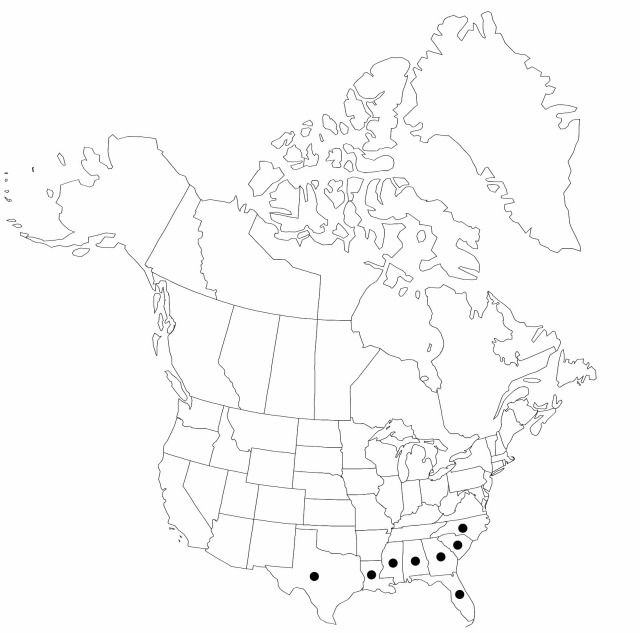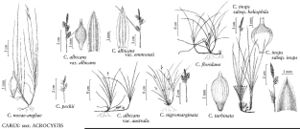Carex floridana
Ann. Lyceum Nat. Hist. New York 1: 66. 1824.
Plants densely cespitose; rhizomes horizontally spreading to ascending, reddish-brown, 17–75 mm, stout. Culms 5–17 cm, scabrous distally; bases (remnants of old leaves) weakly fibrous. Leaf-blades green, occasionally glaucous, exceeding culms, 1.7–3 mm wide, herbaceous, papillose to scabrous abaxially, papillose to scabrous adaxially. Inflorescences with both staminate and pistillate spikes; peduncles of staminate spikes 0.3–1.2 mm; proximal cauline bracts leakflike, shorter than inflorescences. Spikes: proximal pistillate spikes 2–3 (basal spikes 0); cauline spikes overlapping, proximal 2 separated by less than 7 mm, with 4–8 perigynia; staminate spikes (3–) 6.1–9.3 × 1.1–1.7 mm. Scales: pistillate scales pale to dark reddish-brown, with narrow white margins, ovate to lanceolate, 2.7–4.2 × 1.2–2 mm, shorter than to equaling perigynia, apex acute to acuminate or short-aristate; staminate scales lanceolate, 2.8–4 × 1.2–1.8 mm, apex obtuse or acute to acuminate. Anthers 1.8–2 mm. Perigynia pale green, veinless, ellipsoid, 3–4.1 × 0.9–1.4 mm; beak straight, pale green, 0.6–0.9 mm, weakly ciliate-serrulate, apical teeth 0.1–0.3 mm. Stigmas 2 (–3). Achenes brown, ellipsoid, biconvex, flattened-trigonous, or evenly trigonous with convex sides (all three types may occur on the same plant), 1.5–2 × 0.9–1.3 mm.
Phenology: Fruiting early Feb–late Apr.
Habitat: Dry, sandy loam or sand, in partial shade of mixed pine-hardwood forests or full sun along open roads and forest edges
Elevation: 0–200 m
Distribution

Ala., Fla., Ga., La., Miss., N.C., S.C., Tex.
Discussion
Carex floridana usually has been recognized as a distinct species in recent years; the distinctions from C. nigromarginata are subtle. To further complicate matters, some specimens are incomplete, lacking either complete bases or mature perigynia, rendering them unidentifiable. We have retained the two taxa at specific rank; further examination of their morphology, cytology, and ecology is warranted.
Selected References
None.
Lower Taxa
"shortened" is not a number.
